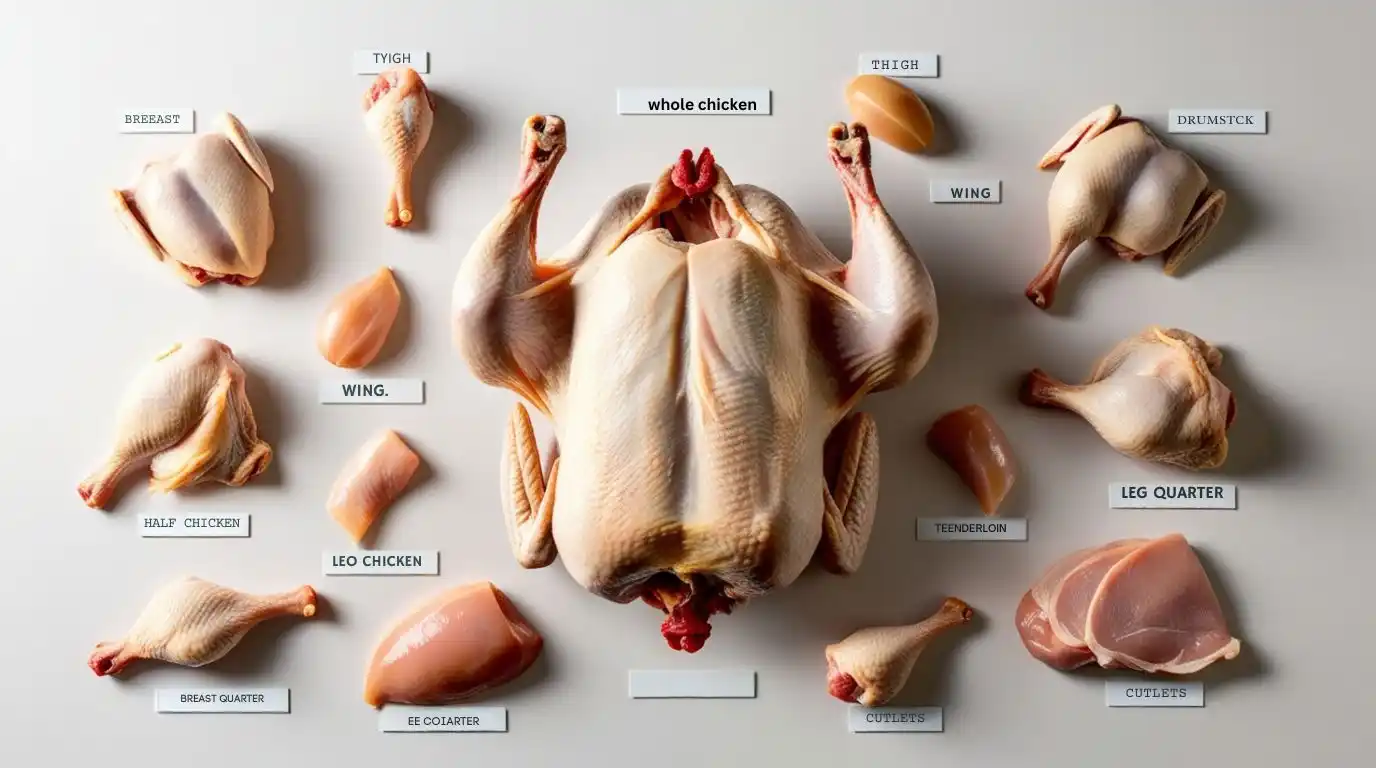Chicken, a staple protein in cuisines worldwide, offers a plethora of cuts, each with its unique flavour, texture, and culinary applications. From succulent thighs to versatile breasts, understanding these cuts empowers home cooks and chefs alike to create delicious dishes. Let’s delve into the world of chicken cuts.
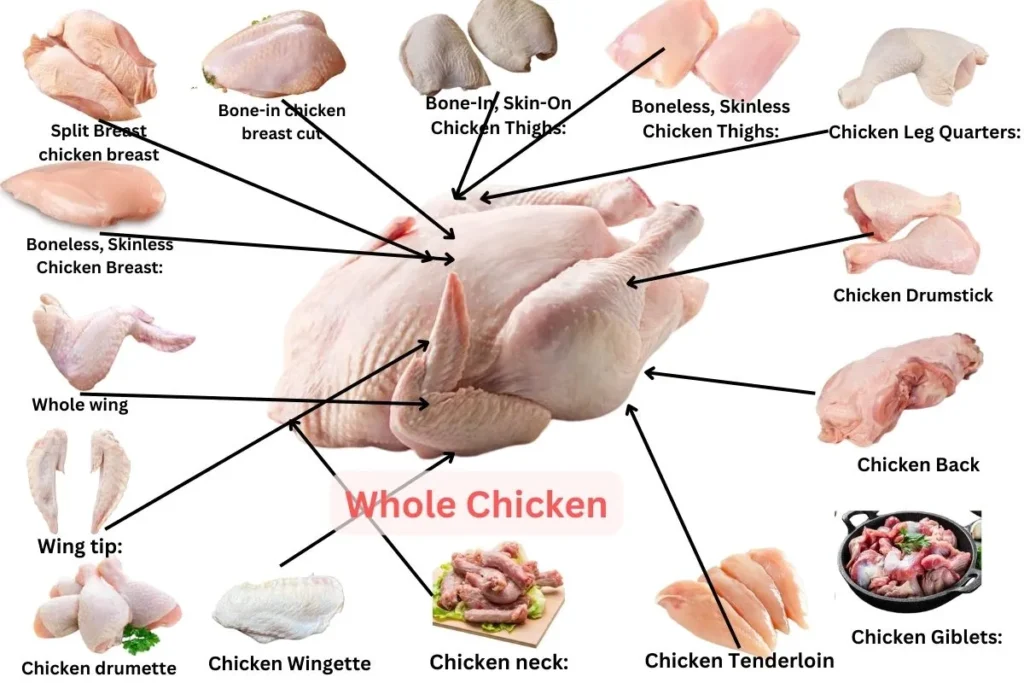
1. Whole Chicken:
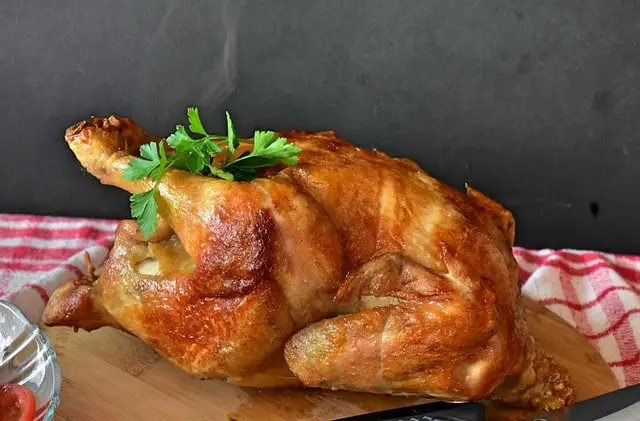
A whole chicken includes all parts of chicken cut, breast, thighs, drumsticks, wings, and sometimes giblets. It provides more options for dishes than buying a specific cut. One of the greatest advantages of cooking with whole chicken cuts is their versatility. Whether you’re roasting, grilling, frying, or simmering, there’s a cooking method to suit every taste and occasion.
Best Uses: Ideal for roasting, providing versatility in cooking methods and flavours. Also perfect for making homemade chicken stock or broth.
Also Read: 10 different Cuts of fish
2. Chicken Breast:
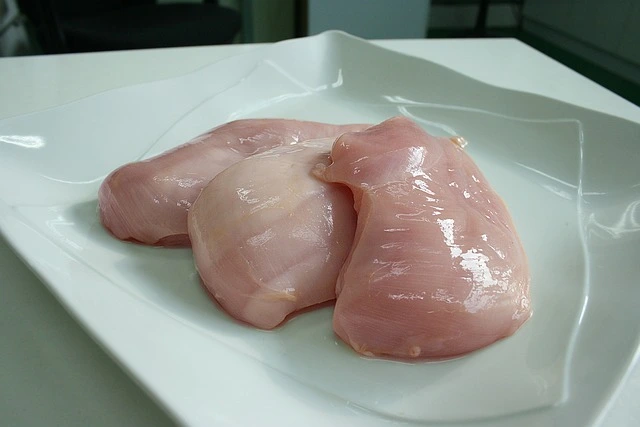
Chicken breast is white meat located on the front of the chicken, known for its lean texture. The most popular cuts are more expensive than thighs, wings, and legs.
Types of chicken breast cuts
1. Boneless, Skinless Chicken Breast:
Chicken breast without bones or skin, provides a lean and versatile option. This type is the most expensive breast cut and is extremely popular in the US.
Best Uses: Ideal for grilling, baking, stir-frying, and sautéing. Commonly used in salads, sandwiches, wraps, and as standalone entrees.
2. Split Breast chicken breast
Split chicken breasts, also known as split chicken breast halves, are a type of chicken cut that consists of the breast portion of the chicken split into two halves, typically with the bone and skin intact.
This cut is created by splitting the whole chicken along the breastbone, resulting in two halves, each containing one side of the breast and attached to a portion of the rib cage and wing.
Best uses: Split chicken breasts can be used in a wide range of recipes, including casseroles, salads, sandwiches, soups, and pasta dishes.
3. Bone-in chicken breast cut
Bone-in chicken breast cuts feature chicken breasts with the bone still attached, including the breast bone (keel bone), rib cage, and often the skin. This cut provides rich flavour and succulent texture, perfect for various cooking methods.
Best use: roasting, grilling, or pan-searing, and Suitable for stuffing and serving as a hearty main course.
3. Chicken Thigh:
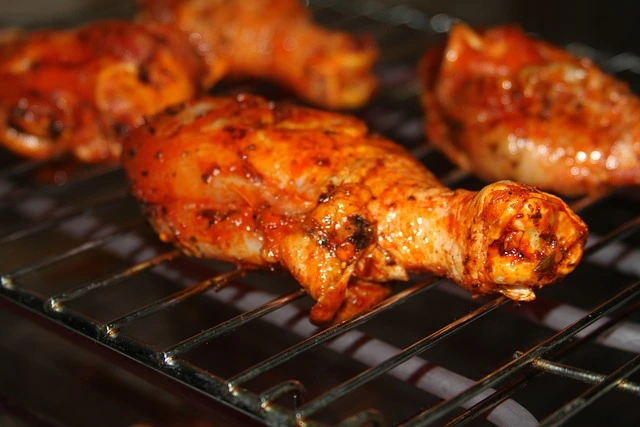
Chicken thigh is Dark meat, this chicken cut comes from the underside of the animal between the legs and wings and is prized for its moistness and flavour. Thigh meat is darker and contains more oil than breast meat, making it a juicier cut that’s much more forgiving when slightly overcooked.
Types of chicken thigh cuts
1. Bone-In, Skin-On Chicken Thighs:
Thighs with the bone and skin intact, Also known as thigh cutlets. It is Juicy and flavorful, with the skin adding crispiness and the bone enhancing the taste. The bone creates a juicer cut of meat cheaper than a thigh fillet.
Best use: Ideal for grilling, roasting, baking, or braising. The bone and skin help retain moisture during cooking, resulting in tender and succulent meat.
2. Boneless, Skinless Chicken Thighs:
Thigh meat without the bone and skin, tender and versatile, with a slightly higher fat content than chicken breast. It is also known as thigh fillets and is more expensive than cutlets.
Best Uses: Suitable for stir-frying, grilling, baking, or sautéing. Boneless, skinless thighs cook quickly and are perfect for recipes where ease of preparation is desired.
Also Read: 14 basic cuts of vegetables with sizes
4. Chicken Drumstick
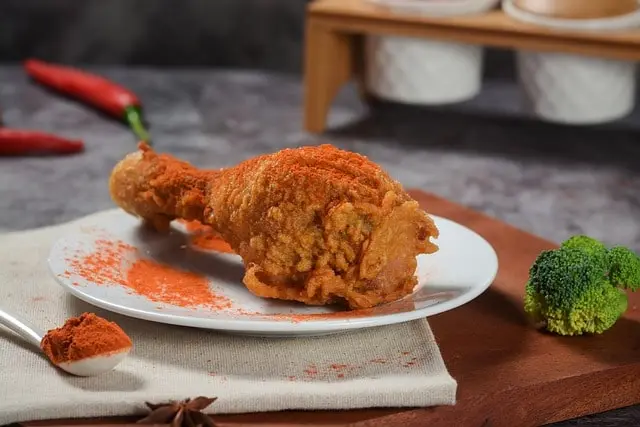
Chicken drumstick cuts consist of the lower portion of the chicken leg, often referred to as the drumstick. This cut includes the thigh bone and the lower leg bone, surrounded by dark meat and covered with skin.
Drumsticks are generally legs with the feet removed. Often served alone as a crowd-pleasing finger food. drumstick meat is very juicy and flavorful. Chicken drumsticks are versatile and flavorful, making them a favourite choice for many recipes and occasions. Whether grilled, baked, fried, or braised, they are sure to satisfy your taste buds and please a crowd.
- Best Uses: Excellent for grilling, baking, or frying. Popular as finger foods, appetizers, or hearty meals.
5. Chicken Wing:
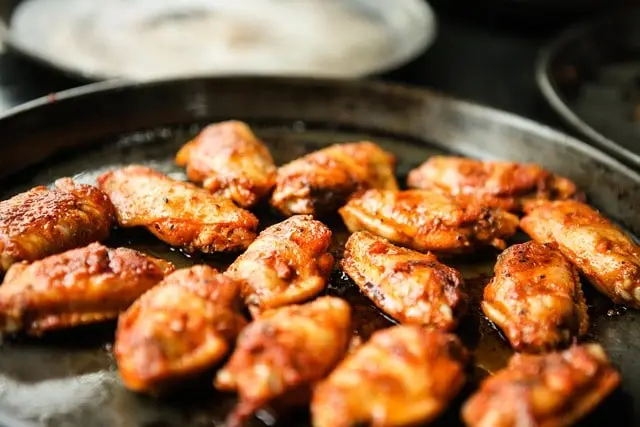
Wings do not supply very much meat but are ideal and very popular for parties or finger food. Wings may be served whole or into three parts: wing tip, winglette, and wing drumette. Cheaper than breasts or thighs, wings contain less meat than other cuts of chicken.
Types of Chicken Wing Cuts
1. Whole wing
As the name implies, a whole chicken wing includes without giblets at the joint between the humerus and the backbone. The wing has three sections: at the end, a pointy tip that offers very little in the way of meat; the middle portion, a double-boned wingette often called the flat; and, where the whole wing joins the chicken’s body, a drumette.
Beast use: Whole chicken wings are versatile and perfect for making classic Buffalo wings, grilled wings, baked wings, Asian-inspired wings, or even stuffed wings. Their flavorful meat and crispy skin make them a delicious choice for any occasion.
2. Wingtip:
The Wingtip Chicken Cut, often overlooked but full of flavour potential, is the part of the chicken wing that includes the tip section. While it may be smaller compared to other parts of the wing, it packs a punch in terms of taste and texture.
Best use: The wingtip chicken cut, though small, is mighty in flavour. Use it to enrich stocks, create savoury sauces, or fry up crispy snacks. Its versatility makes it a valuable addition to your culinary repertoire, ensuring nothing goes to waste in the kitchen.
3. Chicken drumette
A chicken drumette resembles a mini drumstick and is between the second joint and the shoulder. It’s the thickest part of the wing and the easiest to eat. Chicken drumette cuts are the small, meaty sections of the chicken wing that resemble miniature drumsticks. They are located between the shoulder and the elbow joints of the chicken wing and contain a single bone surrounded by tender meat.
Best use: Chicken drumette cuts are perfect for appetizers, snacks, or main courses. Their small size and meaty texture make them ideal for finger foods, whether you’re baking, frying, grilling, or slow-cooking them.
4. Chicken Wingette
The chicken wingette is the middle section of the wing, between the drumette and the wing tip. The wingette, also known as the “flat” or “wing flat,” consists of two thin bones surrounded by tender meat. This part of the wing is popular for its versatility and ability to absorb flavours.
Best use: Wingette chicken cuts are perfect for appetizers, snacks, or main dishes. With their tender meat and versatility, they’re also ideal for grilling, frying, and baking.
6. Chicken Tenderloin:
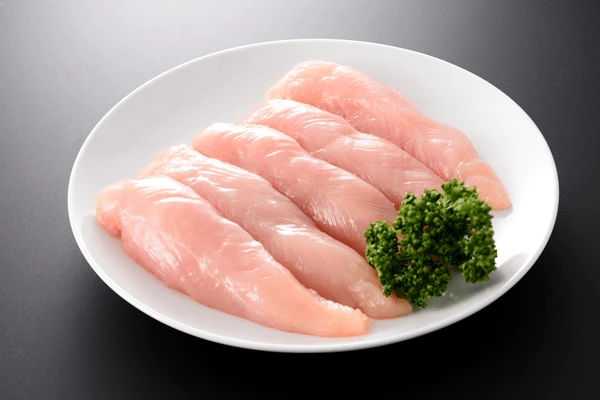
Chicken tenderloins are small, elongated cuts of meat located on the underside of the chicken breast. They are known for their tender texture and mild flavour, making them a favourite among home cooks and professional chefs alike. Unlike chicken breasts, which can sometimes be dry and tough, tenderloins are consistently juicy and tender, making them perfect for a wide range of dishes.
Best Uses: Perfect for grilling, pan-searing, baking, or stir-frying, they’re ideal for salads, sandwiches, wraps, or as standalone mains. Infuse them with flavours like lemon herb, honey mustard, teriyaki,
7. Chicken Leg Quarters:
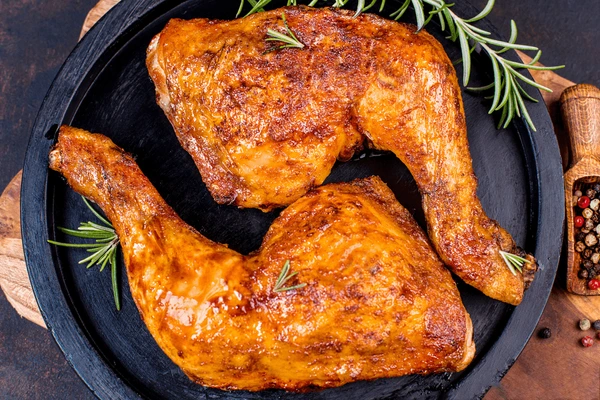
Chicken leg quarters are a popular and versatile cut of chicken that includes both the thigh and drumstick portions, still attached at the joint. This cut is obtained by separating the leg portion of the chicken from the rest of the bird during butchering. It consists of dark meat, which tends to be more flavorful and juicy compared to white meat cuts like the breast.
Best Uses: Great for roasting, grilling, or braising. Perfect for family dinners or barbecue gatherings.
8. Chicken Back:
The chicken back is the rear portion of the chicken, consisting of the backbone and surrounding meat. While it may not be as meaty as other cuts, it offers plenty of flavour and versatility when prepared correctly. Pieces of the back are also part of some wing and leg cuts, and there’s often not much meat left of this cut after butchering the rest of the bird. Chicken back cuts are typically sold whole or in parts, making them an economical choice for budget-conscious cooks.
Best Uses: Perfect for simmering to make flavorful chicken broth or soup base.
9. Chicken Giblets:
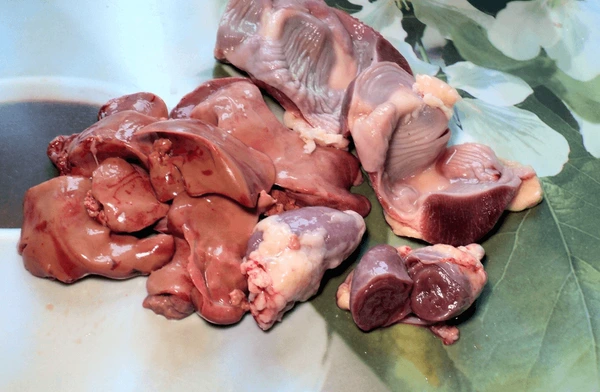
Chicken giblets refer to the edible internal organs of poultry, typically including the heart, liver, gizzard, and sometimes the neck. These organs are often packaged together and included inside the cavity of whole chickens or turkeys sold in supermarkets or butcher shops. While they may not be as commonly consumed as other parts of the bird, such as the breast or thighs, chicken giblets are prized by many cooks for their rich flavour and nutritional value.
Best Uses: They can be used in various culinary applications, such as stocks, gravies, sauces, stuffings, and even as the main ingredient in dishes like pâtés or sautéed giblets.
10. Chicken neck:
When it comes to chicken, most of us are familiar with popular cuts like breasts, thighs, and drumsticks. However, there’s one often-overlooked part of the bird that packs a punch in terms of flavour and versatility: the neck. While it may not be as commonly featured in recipes or showcased at the butcher counter, chicken necks offer a range of culinary possibilities that are worth exploring.
Best Uses: They are used in Rich Stocks & Broths, Hearty Stews & Braises, Nutrient-Rich Bone Broth, Enhanced Stuffings.
Conclusion:
With a diverse array of cuts, chicken offers endless possibilities in the kitchen. Whether you’re a novice cook or a seasoned chef, understanding the characteristics and best uses of each cut enhances your culinary prowess. From succulent thighs to crispy wings, explore the versatility of chicken cuts and elevate your cooking to new heights.
FAQ
What are the different cuts of chicken?
The main cuts of chicken include whole chicken, breasts, thighs, drumsticks, and wings. Each cut has unique characteristics and cooking methods, making them suitable for different recipes.
How do I choose the right cut of chicken for my recipe?
Choosing the right cut of chicken depends on the cooking method and the dish you are preparing. For example, chicken breasts are great for grilling or sautéing, while thighs are ideal for braising or slow cooking due to their richer flavor.
What is the difference between white meat and dark meat in chicken?
White meat, found in the breasts and wings, is leaner and has a milder flavor, while dark meat, found in the thighs and drumsticks, is richer, juicier, and more flavorful due to a higher fat content.
How can I cook different cuts of chicken?
Different cuts of chicken require various cooking techniques. For instance, breasts can be grilled, sautéed, or baked, while thighs can be braised or roasted. Drumsticks are perfect for frying or baking, and wings are often deep-fried or grilled.
Related Post
Subscribe and join our community of hospitality professionals & students — get insights, tips, and the latest updates delivered straight to your inbox!

